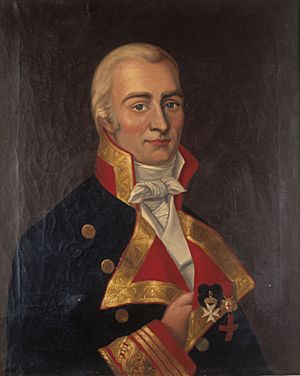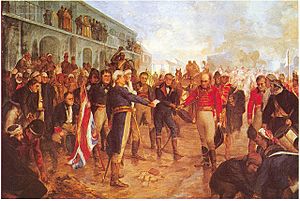Santiago de Liniers, 1st Count of Buenos Aires facts for kids
Quick facts for kids
The Most Illustrious
The Count of Buenos Aires
|
|
|---|---|

Portrait of Liniers, Naval Museum of Madrid
|
|
| 10th Viceroy of the Río de la Plata | |
| In office February 10, 1807 – June 30, 1809 |
|
| Monarch | Charles IV of Spain – Junta of Seville |
| Preceded by | Rafael de Sobremonte |
| Succeeded by | Baltasar Hidalgo de Cisneros |
| Personal details | |
| Born |
Jacques de Liniers
July 25, 1753 Niort, France |
| Died | August 26, 1810 (aged 57) Cabeza de Tigre, Viceroyalty of the Río de la Plata |
| Political party | Royalist |
| Spouses | Martina de Sarratea (1772–1805), elder sister of Manuel de Sarratea |
| Domestic partners | Ana Perichon between 1806 and 1808 |
| Occupation | Naval officer |
| Signature |  |
| Military service | |
| Allegiance | |
| Battles/wars | |
Santiago de Liniers (born Jacques de Liniers) was a French officer who served in the Spanish military. He became a very important leader in the Spanish colonies of the Viceroyalty of the River Plate, which included parts of modern-day Argentina, Uruguay, Paraguay, and Bolivia.
He is famous for being a hero in Buenos Aires. He helped defend the city against two attacks by the British. Because of his bravery, he was made the viceroy, a top leader, of the region. This was a big deal because viceroys were usually chosen directly by the King of Spain.
Later, Liniers faced new challenges, including a rebellion and political changes in Spain. He was eventually replaced as viceroy. When a new revolution started in Buenos Aires, he tried to organize a group to support the Spanish King. However, he was captured and sadly, he was executed.
Contents
Early Life and Military Training
Santiago de Liniers was born in France in 1753. His full name was Santiago Antonio María de Liniers y Bremond. His family was part of the French nobility, meaning they had a long history of important ancestors.
When he was 12, Santiago joined a military academy. This was a common path for younger sons in noble families. After three years, he graduated and became a Sub-Lieutenant in the French army.
Serving the Spanish Crown
In 1774, Liniers decided to join the Spanish military. He volunteered for campaigns against groups in Algiers (North Africa). Spain and France had an agreement that allowed French people to serve in the Spanish military.
In 1775, he officially became an Ensign in the Spanish Navy. The next year, he sailed to the Viceroyalty of the Río de la Plata. He helped Spain take over Santa Catarina Island and attack Colonia del Sacramento (in modern-day Uruguay).
Liniers also fought in the American Revolutionary War. Spain joined France and the American colonies against Britain. Liniers showed great courage. In 1780, he captured a large British ship. In 1782, he bravely took two British ships loaded with weapons during a siege. For this, he was promoted to Frigate Captain.
He later went on a mission to Algiers to stop pirates who were attacking European ships and taking prisoners. Liniers was successful in negotiating the release of several European prisoners. The Spanish King rewarded him by making him a captain. In 1788, he was sent back to the Río de la Plata to lead a group of gunships. He brought his first wife and son with him, but his wife passed away two years later. He then married María Martina Sarratea in Buenos Aires.
Defending Buenos Aires: The British Invasions
The early 1800s were a time of big wars in Europe, called the Napoleonic Wars. Britain needed new places to trade, so they decided to attack Spanish colonies in South America. Spain was allied with France at the time.
First British Attack

In June 1806, a British force of 1,700 soldiers landed near Buenos Aires. The city's leader, the viceroy, left the city. But Liniers stayed hidden. He then went to Montevideo and gathered 1,200 volunteers.
On August 4, Liniers and his small army returned to Buenos Aires. They fought hard in the streets. The British general, William Carr Beresford, surrendered. Liniers became a hero for taking back the city. The British flags he captured are still kept in a church in Buenos Aires.
Second British Attack
After this victory, people in Buenos Aires were ready for another British attack. They made Liniers the commander-in-chief. He organized the city's defense, training all men who could fight, even African slaves. They even melted down lead from pipes and cutlery to make weapons!
A much larger British force arrived the next year. They first attacked and took Montevideo. The leaders in Buenos Aires then decided to remove the old viceroy and made Liniers the temporary viceroy. This was a very unusual step.
In 1807, the British attacked Buenos Aires again with 23 ships and 11,000 soldiers. Liniers led his forces out to meet them but was defeated. However, he managed to retreat back into the city. The British entered Buenos Aires but faced strong resistance. Many British groups were defeated in street fighting. The British leader, John Whitelocke, asked for a truce. Liniers refused and continued to fight. Whitelocke was completely defeated. Liniers demanded that all British forces leave the region within two months and that prisoners be exchanged. Whitelocke agreed and surrendered.
Becoming Viceroy and Facing New Challenges
After the second victory, Liniers was officially made viceroy in May 1808. He was also given the special title "Count of Buenos Aires."
However, these victories, achieved by the people of Buenos Aires without help from Spain, started new political ideas. Some people began to think about independence. Liniers, who was a great leader in wartime, now faced criticism from different groups.
- Some Spanish leaders worried that the local armies, made up of people born in the Americas (called criollos), were becoming too powerful.
- On the other hand, the criollos who wanted more independence found it hard to understand Liniers's strong loyalty to the King of Spain.
Liniers was French by birth. This became a problem when France invaded Spain and removed the Spanish King. Even though Liniers clearly stated he was loyal to Spain and refused to accept the new French king, his political enemies spread rumors that he was secretly working with the French. They also encouraged anti-French feelings that were happening in Spain to try and hurt Liniers's reputation.
A new government council, called the Junta of Seville, was formed in Spain. Both criollos and Spanish people in the Americas saw this as a chance to create their own local governments. However, they disagreed on how these governments should work. In Montevideo, a local leader created his own council. Another leader in Buenos Aires tried to do the same, but Liniers's forces stopped him.
The Junta of Seville then appointed a new viceroy, Baltasar Hidalgo de Cisneros. Some criollos wanted Liniers to use his army to resist this change. But Liniers chose not to fight. He peacefully gave up his power.
After leaving his position, Liniers moved to a town called Alta Gracia in Córdoba province.
His Final Stand and Execution
In May 1810, the May Revolution began in Buenos Aires. This was a big step towards Argentina's independence. When news reached Córdoba, Liniers decided to get involved. He joined other leaders in Córdoba who wanted to stay loyal to the Spanish King and fight against the new government in Buenos Aires.
Liniers tried to gather an army to fight Buenos Aires. However, his army faced many problems like spies and people leaving. When the troops from Buenos Aires got close, Liniers's army fell apart. Liniers and the other leaders tried to escape, but they were all captured.
The commander who captured them didn't want to execute them because they were popular. So, he sent them to Buenos Aires as prisoners. But the new government in Buenos Aires was worried that Liniers's arrival in the city might cause more trouble. So, they sent an officer with orders to execute the prisoners. Liniers and the other captured leaders were executed by a firing squad on August 26, 1810.
What is His Legacy?
Liniers was recognized as a hero during his lifetime. A street in Buenos Aires was even named after him after his victories against the British. Later, after the Argentine War of Independence, many street names were changed to honor new heroes. The old Liniers street is now called Defensa and Reconquista streets.
However, Liniers's importance was recognized again over time. A neighborhood in Buenos Aires is named Liniers after him. There's also a town called Santiago de Liniers in the Misiones Province.
In 1861, the Queen of Spain asked for Liniers's body to be returned to Spain. His remains were buried in a special place for famous naval officers in Spain. His descendants were given a new title, "Count of Loyalty."
His old house in Alta Gracia, Argentina, was later turned into a museum in 1977. In 2000, it was declared a special heritage site by UNESCO.
- A famous painting called La Reconquista de Buenos Aires shows Liniers during the recapture of Buenos Aires.
- A novel called El último virrey (The Last Viceroy) is based on Liniers's life.
Images for kids
-
Museum at the former house of Liniers, at Alta Gracia in Córdoba Province, Argentina.
See also
 In Spanish: Santiago de Liniers para niños
In Spanish: Santiago de Liniers para niños





